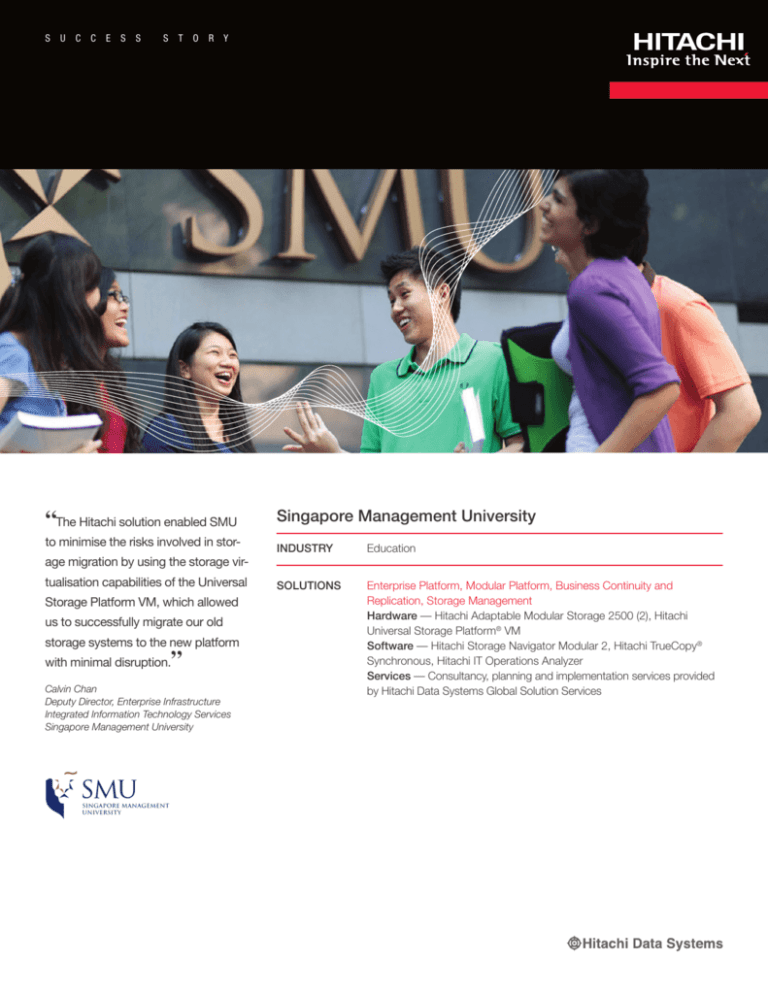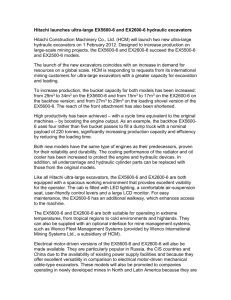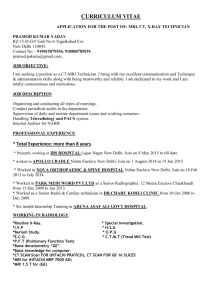
S
U
C
C
E
S
S
S
T
O
R Y
“The Hitachi solution enabled SMU
to minimise the risks involved in storage migration by using the storage virtualisation capabilities of the Universal
Storage Platform VM, which allowed
Singapore Management University
INDUSTRYEducation
SOLUTIONS
us to successfully migrate our old
storage systems to the new platform
”
with minimal disruption.
Calvin Chan
Deputy Director, Enterprise Infrastructure
Integrated Information Technology Services
Singapore Management University
Enterprise Platform, Modular Platform, Business Continuity and
Replication, Storage Management
Hardware — Hitachi Adaptable Modular Storage 2500 (2), Hitachi
Universal Storage Platform® VM
Software — Hitachi Storage Navigator Modular 2, Hitachi TrueCopy®
Synchronous, Hitachi IT Operations Analyzer
Services — Consultancy, planning and implementation services provided
by Hitachi Data Systems Global Solution Services
S
U
C
C
E
S
S
S
T
O
R Y
2
Singapore Management University Minimises
Storage Migration Risks with Hitachi Modular and
Enterprise Storage
The Singapore Management University (SMU) had been seeking
to upgrade its storage systems as part of its technology refresh
cycle. With many mission-critical applications riding on the storage infrastructure, it was imperative to minimise downtime during
the data migration process. This was one of the key reasons SMU
decided to partner Hitachi Data Systems for its storage upgrade.
The university deployed Hitachi Adaptable Modular Storage 2500
with the Hitachi Universal Storage Platform® VM to handle backend virtualisation to ensure minimal disruption during migration.
SMU was established in January 2000 as
Singapore’s first publicly funded autonomous university to offer a style of education modelled after the globally recognised
Wharton School of the University of
Pennsylvania. Its state-of-the-art city campus is located in the heart of Singapore's
bustling Civic District. Today, SMU has
more than 7,000 students and comprises
6 schools: School of Accountancy, Lee
Kong Chian School of Business, School
of Economics, School of Information
Systems, School of Law and School of
Social Sciences. It also has about 700
staff, including some 300 faculty recruited
from around the world.
Email, teaching and learning, student
administration, finance and human resource
management are some mission-critical applications that support the staff and students
of SMU in their daily work. Underpinning
these applications is a storage infrastructure
that is vital to the smooth functioning of the
university and its programmes.
The SMU storage infrastructure spans 2
sites, a primary and a secondary data centre,
to allow for redundancy and site resiliency. In
the past, it had 2 storage systems located at
each site: one for servers with high criticality
and high performance and one for servers
with medium and low performance. These
were connected through storage area
network (SAN) switches.
In 2010, as part of the university’s technology refresh cycle, SMU decided to upgrade
its storage infrastructure to capitalise on
new technologies that will facilitate storage
management and lower the total cost of
ownership (TCO).
The university evaluated proposals from
several vendors before deciding to opt for
Hitachi Data Systems. This was not just
because of the features, functionalities and
lower total cost of ownership (TCO) of the
proposed Hitachi solution, but also because
Hitachi back-end virtualisation capabilities
would enable SMU to minimise the downtime involved in storage migration.
Key Considerations
Downtime was an important consideration
given the mission-critical nature of the applications riding on the storage infrastructure.
For example, an estimated 5,000 to 6,000
users could be online at any time accessing
the email system. Equally important are the
teaching and learning applications.
Sudharsanan Ranganathan, Manager with
SMU’s Integrated Information Technology
Services, said, “Imagine if you are about to
teach a class and the application breaks
down, what would you do for the next one
and a half hours?”
The teaching and learning system is
accessed not just by students in the university’s 100 or more classrooms, but also
those in discussion groups or individuals
preparing for classes. Sudharsanan estimates that about 2,000 students use the
“With the previous storage solution, we had to engage the vendor’s
services in order to provision storage space. The Storage Navigator
Modular 2 has enabled us to do this by ourselves. This has effectively
reduced onsite support and, therefore, results in lower TCO.”
Sudharsanan Ranganathan
Manager
Integrated Information Technology Services
Singapore Management University
S
U
C
C
E
S
S
S
T
O
R Y
3
teaching and learning application during
the university’s operating hours.
also took the opportunity of the term break
and the recess week,” said Sudharsanan.
excluding the downtime that SMU had
scheduled for applications testing.
Scheduling downtime for any system,
therefore, has never been easy. “We have
students, faculty and staff working round
the clock. We cannot afford to have the
services go down, and if there is downtime, it has to be scheduled and kept very
minimal,” said Sudharsanan.
Before moving each batch of servers, the
storage administration team would carry
out pre-check activities to make sure that
all processes were in place and that all required tasks related to migration were taken
care of. These included back-end configuration and SAN switch zoning, as well as
checking on the Fibre Channel connections.
After each batch of servers was moved to
the new storage infrastructure, SMU also
scheduled downtime for application testing
before bringing the system up again.
Alternative solutions proposed by other
vendors, such as host-to-host migration,
could involve a downtime of about 8 to 12
hours for migrating about 400GB of data,
Sudharsanan estimated.
Selection and Implementation
The Hitachi proposal got the nod because
the risks were minimal and scheduled
downtime would be minimised. The solution involved the use of Hitachi Universal
Storage Platform (USP) VM to migrate
data from the old storage systems to the
new Hitachi Adaptable Modular Storage
(AMS) 2500.
Based on USP VM, unique Hitachi virtualisation capability masks complexity and
presents all heterogeneous storage as
a single pool that can be controlled and
optimised simply and centrally using a
powerful suite of management tools. In the
SMU example, the USP VM was used to
virtualise the university’s existing storage
systems and the new AMS 2500 into one
pool. This gave users uninterrupted access
to the data even as it was being moved
from the previous storage to the new AMS
2500. The nondisruptive data migration was
carried out using Hitachi Tiered Storage
Manager, which allows seamless, transparent data volume movement among any
storage systems attached to the USP VM.
The deployment of the new storage solution and the planning and execution of
the storage migration was carried out by
the Hitachi Data Systems Global Solution
Services team.
SMU had about 40 servers connected to
the storage infrastructure, with 20 servers at each site. These were cut over to
the new platform in batches whenever
downtime was available. In all, the planned
migration took about 3 months. “We would
cut over the systems whenever we could
find the slots to do so. So every weekend,
we would move about 3 or 4 servers. We
With the new storage infrastructure, the
medium- and high-performance storage
systems previously deployed at each of
the data centers were consolidated onto a
single AMS 2500, with about 40TB of storage at each site. The 2 sites are maintained
as an active-active cluster, with data mirrored using Hitachi TrueCopy® Synchronous
replication. Hitachi IT Operations Analyzer
was also deployed for events monitoring.
Reduced Downtime with
Virtualisation and Seamless
Storage Migration
With USP VM, SMU was able to make use
of unique Hitachi virtualisation capabilities
to present existing storage systems and
the new AMS 2500 as one data pool. This
allowed seamless storage migration to
take place in the background, without impacting users’ access to the data residing
on heterogeneous storage systems.
“The Hitachi solution enabled SMU to
minimise the risks involved in storage migration by using the back-end virtualisation
capabilities of the USP VM, which allowed
us to successfully migrate our old storage
systems to the new platform with minimal
disruption,” said Calvin Chan, Deputy
Director of Enterprise Infrastructure and
project lead of this SMU storage upgrade.
With the data migration taking place at the
back end, the servers only had to reboot
to the new storage when ready. In effect,
this reduced the downtime involved in
storage migration to less than an hour,
Lower TCO through Self-service
Storage Management
The Hitachi solution enables SMU to do
self-service storage provisioning and management through Hitachi Storage Navigator
Modular 2 (HSNM 2), a software that
enables essential functions for the management and optimisation of individual Hitachi
storage systems. HSNM 2 provides both
a web-accessible graphical management
interface and a command line interface to
allow ease of storage management.
“HSNM 2 is a user-friendly tool,” said
Sudharsanan. “With the previous storage
solution, we had to engage the vendor’s
services in order to provision storage
space. HSNM 2 enables us to do this by
ourselves. This has effectively reduced onsite support and, therefore, lowered TCO,
through lower cost of services.”
Consolidation of Disparate
Storage Systems
Besides consolidating previous mid- and
high-performance storage systems onto
the same platform, the new Hitachi solution has also allowed SMU to bring other
disparate network attached storage (NAS)
systems onto AMS 2500. “Previously,
storage was acquired on a project basis,
so we had separate NAS for separate
projects,” explained Sudharsanan.
Today, a new approach to storage acquisition and the emergence of new technologies provide SMU with an opportunity to
consolidate these disparate systems onto
a single box, lowering the maintenance
cost. “The Hitachi solution has been able
to support the consolidation of different
platforms, such as [Microsoft] Windows,
Linux and UNIX, thereby providing scalability and resiliency,” said Sudharsanan.
S
U
C
C
E
S
S
S
T
O
R Y
Corporate Headquarters
750 Central Expressway
Santa Clara, California 95050-2627 USA
www.HDS.com
Regional Contact Information
Americas: +1 408 970 1000 or info@hds.com
Europe, Middle East and Africa: +44 (0) 1753 618000 or info.emea@hds.com Asia Pacific: +852 3189 7900 or hds.marketing.apac@hds.com
Hitachi is a registered trademark of Hitachi, Ltd., in the United States and other countries. Hitachi Data Systems is a registered trademark and service mark of Hitachi, Ltd.,
in the United States and other countries.
All other trademarks, service marks and company names in this document or website are properties of their respective owners.
Notice: This document is for informational purposes only, and does not set forth any warranty, expressed or implied, concerning any equipment or service offered
or to be offered by Hitachi Data Systems Corporation.
© Hitachi Data Systems Corporation 2012. All Rights Reserved. SS-325-A DG May 2012







